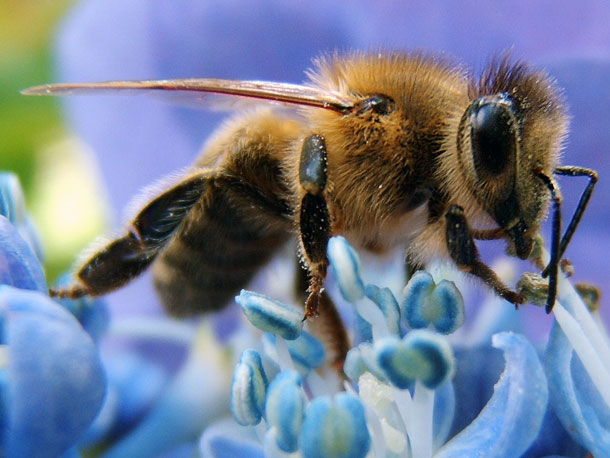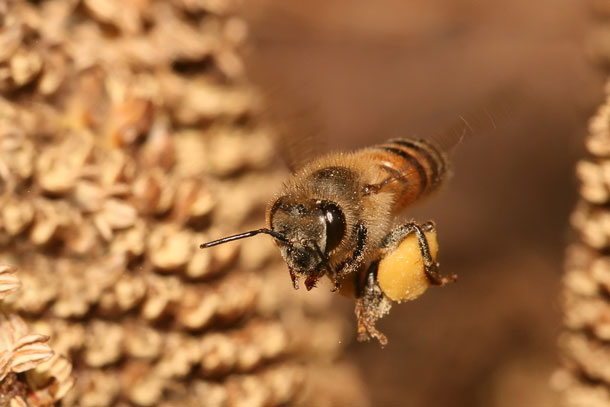Emerging Science Note: Backyard Garden Threat to Bees
Air Date: Week of July 1, 2016

There are fewer than 10 different honeybee species -- a fraction of the 20,000 known species of bees. (Photo: Louise Docker, Wikimedia Commons CC BY 2.0)
: Pesticides are a leading contributor to recent widespread declines in honeybee populations. But don’t blame farmers. As Living on Earth’s Jay Feinstein reports in this note on emerging science, a new study in Nature magazine found a large amount of bees’ pesticide exposure came from non-cultivated areas, including backyard gardens.
Transcript
CURWOOD: It’s Living on Earth, and I’m Steve Curwood. In a minute, one man’s weed is another’s urban pioneer, but first this note on emerging science from Jay Feinstein.
[SCIENCE NOTE THEME]
FEINSTEIN: 80 percent of pesticides used in the U.S. are sprayed on agricultural sites, according to the EPA. Environmental advocates often argue this is partly responsible for the recent widespread decline of honeybees. Yet, a new Purdue University study suggests that key to helping save these vital pollinators is what we do in our own backyards.

The Western Honey Bee, also known as the European Honeybee, is the most common honeybee worldwide. (Photo: Ricks, Wikimedia Commons CC BY-SA 3.0)
Scientists found that contrary to popular belief, most of the pesticide-ridden pollen bees gather may be from urban landscapes and non-cultivated plants. For 16 weeks, researchers collected pollen from bees at three different sites in Indiana and analyzed it for pesticides. They chose locations with wildflowers, shrubs and trees to test non-agricultural sites. Then, they tested different sites at the border of maize fields in areas that received chemical treatments such as the neonicotinoid Clothianidin and finally areas that received no treatments.
The researchers found that bees collected a much larger amount of pollen from the non-cultivated plants than from the food crops and that the samples from these uncultivated areas also contained a larger amount of pesticides. This suggests that pesticide exposure for bees in non-agricultural sites may be higher than previously thought and they found that pyrethroid insecticides, commonly used by homeowners to kill pests like mosquitoes, were present in the largest quantities and also likely cause the most harm to bees.

A Western Honey bee bringing pollen back to its hive. (Photo: Muhammad Mahdi Karim, Wikimedia Commons GFDL 1.2)
The scientists note that these results provide important information on bee foraging habits and bee hazards, along with tips gardeners might consider when treating their yards.
That’s this week’s Note on Emerging Science. I’m Jay Feinstein.
[SCIENCE NOTE THEME]
Links
The Nature article about the study
Listen to a previous LOE report on how pollinator declines impact public health
National Geographic: The Last, Best Refuge for North America’s Bees
Living on Earth wants to hear from you!
Living on Earth
62 Calef Highway, Suite 212
Lee, NH 03861
Telephone: 617-287-4121
E-mail: comments@loe.org
Newsletter [Click here]
Donate to Living on Earth!
Living on Earth is an independent media program and relies entirely on contributions from listeners and institutions supporting public service. Please donate now to preserve an independent environmental voice.
NewsletterLiving on Earth offers a weekly delivery of the show's rundown to your mailbox. Sign up for our newsletter today!
 Sailors For The Sea: Be the change you want to sea.
Sailors For The Sea: Be the change you want to sea.
 The Grantham Foundation for the Protection of the Environment: Committed to protecting and improving the health of the global environment.
The Grantham Foundation for the Protection of the Environment: Committed to protecting and improving the health of the global environment.
 Contribute to Living on Earth and receive, as our gift to you, an archival print of one of Mark Seth Lender's extraordinary wildlife photographs. Follow the link to see Mark's current collection of photographs.
Contribute to Living on Earth and receive, as our gift to you, an archival print of one of Mark Seth Lender's extraordinary wildlife photographs. Follow the link to see Mark's current collection of photographs.
 Buy a signed copy of Mark Seth Lender's book Smeagull the Seagull & support Living on Earth
Buy a signed copy of Mark Seth Lender's book Smeagull the Seagull & support Living on Earth

